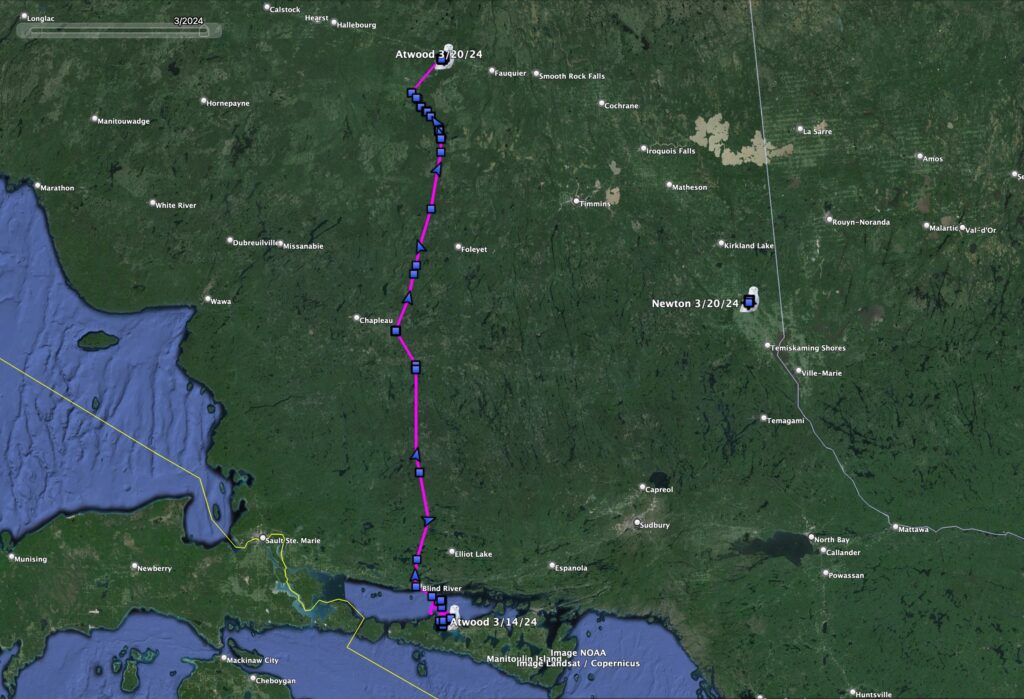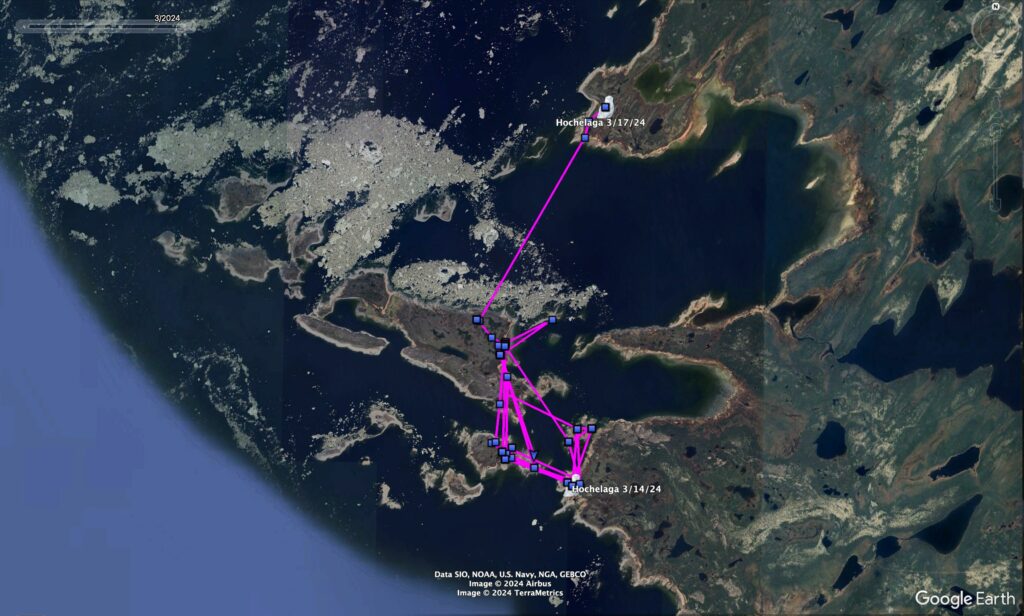
Atwood has pushed about halfway to James Bay, deep in the boreal forest. (©Project SNOWstorm and Google Earth)
Although Newton and Loren remain more or less where they’ve been (in Newton’s case, all winter), Atwood has pushed well to the north while Hochelaga has, in all likelihood, slipped off the cell network for the summer.
On March 20, Atwood was just outside Kapukasing, ON, a longtime timber-and-pulp town whose paper mill’s claim to fame, since 1928, has been to supply all the newsprint used by the New York Times. Atwood was at first hanging around the small airport, which no longer has scheduled flights, but when she checked in that evening she was perched beside the parking lot of a motel and restaurant along that stretch of Highway 11, the local portion of the Trans-Canada Highway. I’m keeping my fingers crossed, since her route is taking her through the middle of the boreal forest, an alien and dangerous environment for a snowy owl, but she’s close to the northern edge where the dense spruce woods start to open up into more welcoming taiga and tundra.

A last hurrah from Hochelaga? (©Project SNOWstorm and Google Earth)
The last time we heard from Hochelaga was March 17, when he was still in the general vicinity of Wemindji, about halfway up the eastern shore of James Bay. Now that the owls’ transmitters are checking in daily, the fact that Hochelaga has missed a few checks suggests he’s moved farther north. There are a number of Indigenous communities along that part of the bay, so we may get lucky with him again, most likely he’ll be off the grid until he comes back south into cell range again next winter.
As I said, Newton seems to be in no rush to leave the Earlton, ON, area where he’s been holed up all winter. Loren has been moving around the area near Saint-Barthélemy, QC, including some time out on the islands in the St. Lawrence. And Otter’s weekly satellite fix on Monday, March 18, showed him still hanging around lower James Bay. (As always these satellite locations are not reflected on his online map, which only includes GSM cellular data.)


4 Comments on “Northward? Yes and No”
Had a male snowy 10 miles SW of Medina, ND the other day!
Had a
Male snowy 10 SW Medina, ND this week
Can you share why you think this is dangerous.. “ her route is taking her through the middle of the boreal forest, an alien and dangerous environment for a snowy owl”.
Thank you!!
Sorry for the slow reply — we lost power and internet for a while from a big ice storm.
Snowy owls are creatures of open land — tundra, fields, shorelines, etc. They’re not adapted to forest settings, and we suspect trying to pass through and roost in deep forest puts them at a serious disadvantage from other predators like eagles, or even mammalian predators if they wind up on the ground. I’ve even wondered if one of the big northern-subspecies great horned owls, like B.v. subarcticus that are almost as big as a small snowy, might be a danger. The truth is, we don’t really know, but we do know that a surprising number of our tagged snowies, especially young birds, disappeared while trying to pass through the boreal forest. If you look at a map that aggregates all of our tracking data, you see a very stark hole in western Ontario in the heart of the boreal, because most of our snowies have skirted around it. And as you’ll see, several that did not simply vanished trying to cross it. Because it’s such a remote area, and these owls tend to wink out when there’s still a lot of snow on the ground, we generally have not been able to get anyone in there to retrieve the carcass for necropsy.